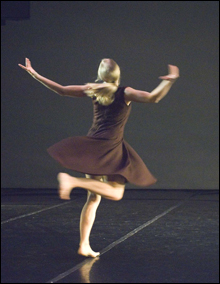
NICOLE PIERCE AND EGOART: You get
another chance to see Go Don’t Go this
weekend at Green Street Studios. |
CRASHarts’ “Ten’s the Limit” was back last weekend for the seventh time, presenting eight mini-dances by eight different choreographers at the Institute for Contemporary Art. The notion of confining entries to 10 minutes seems arbitrary — why not four choreographers doing 20-minute dances? Or 10 doing six-minute dances?
These aren’t entirely rhetorical questions. Yes, “Ten’s the Limit” provides artists with exposure to an audience presumably wider than their extant friends and fans. And I imagine CRASHarts kicks in with some stipends and production support. But the time limitation stunts the growth of new players as well as established ones. With little chance to allow good ideas to develop, or embryonic ones to emerge, most of the pieces on the current series offered movement for its own sake. The dances began to blend into one aimless, giddy indulgence, and the closer, Go Don’t Go, by Nicole Pierce and EgoArt, succumbed to eye fatigue. (That work, however, can be seen again this Friday and Saturday as part of EgoArt’s full evening concert at Green Street Studios.)
Megan Schenk danced her solo a priori/memory in a tailored white ’50s dress with a big flaring skirt. Twirling and sinking, reversing directions, she seemed determined to keep herself decentered. As she was sailing back and forth along a diagonal, we heard the sound of what might have been an airplane in a steep dive. Then a piano began to play some meditative chords. Schenk stood and faced the audience, still twisting and circling her arms.
Nathan Andary used another ’50s dress — designed by Isaac Mizrahi, a black number with peekaboo cutouts in the back — for the woman who began Reciprocity or the Truth. Three other women arrived to relieve her of this outfit and dress her, like themselves, in a red semi-sheath. Then all four of them tottered and bumped around like robots trying to be fashion models.
Brian Crabtree danced with two partners, Yenkuel Chang and Joell Garfi, in Two Face Ed. Their easy stepping, pivoting, swinging movement contrasted with plinking guitars and intrusive voices by the Books. Unperturbed when the music revved up in tempo and intensity, Crabtree paired off with one of the women, then sidled up to the other.
In Kelli Edwards’s Mon Coeur, three women and two men did seem stirred by the cabaret waltzes and laments of Edith Piaf and a Piaf imitator, Jil Aigrot. I thought this dance was influenced by the playful sexiness of Twyla Tharp’s Sinatra duets from the 1980s.
Caitlin Corbett and Kelley Donovan are both capable of working in big choreographic forms, and both of them left me wanting more. Corbett assembled a diverse group of dancers and civilians, among them two men and a couple of young girls, for Tom’s Wealth: A Dance for the Masses (excerpted from a longer work). The troops streamed in and out, blended by Corbett to accommodate their differences. She used a vocabulary based in pedestrian movement, expanded selectively, so that each could take part.
I could hardly retain all the information the nine women in Donovan’s Squirm were offering. Donovan’s gift for expansive, lyrical movement looked cramped in this format, but she did harness it momentarily, with clear group designs.